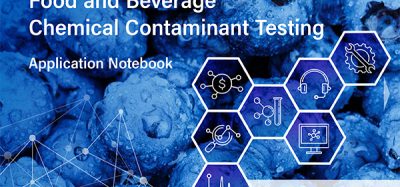Metabolomics as a new technique for nutritional claims discovery and validation
- Like
- Digg
- Del
- Tumblr
- VKontakte
- Buffer
- Love This
- Odnoklassniki
- Meneame
- Blogger
- Amazon
- Yahoo Mail
- Gmail
- AOL
- Newsvine
- HackerNews
- Evernote
- MySpace
- Mail.ru
- Viadeo
- Line
- Comments
- Yummly
- SMS
- Viber
- Telegram
- Subscribe
- Skype
- Facebook Messenger
- Kakao
- LiveJournal
- Yammer
- Edgar
- Fintel
- Mix
- Instapaper
- Copy Link
Posted: 23 April 2015 | Claudio Luchinat and Claudio Santucci, CERM (Magnetic Resonance Center), University of Florence and Leonardo Tenori, FiorGen Foundation | No comments yet
Metabolites are the final products of cellular activities and their levels in a living organism can change according to genetic or environmental factors. The set of metabolites synthesised by a biological system is called ‘metabolome’1. Metabolomics is a further ‘omics’ discipline which deals with the analysis of metabolic responses of living systems to genetic modifications or pathophysiological stimuli2. Metabolomics, as opposed to classical clinical analyses that are based on the quantification of a pre-defined set of analytes, allows monitoring of global changes in metabolic patterns/pathways and provides a global scenario of modifications in a biological system that could be due to complex interactions between genes and environment3.


Mostly common biofluids such as urine and serum/plasma are used for metabolomics studies. These biofluids are easily available from mammals and are used for many other clinical analyses. Mass spectrometry (MS) and proton nuclear magnetic resonance spectroscopy (1H-NMR) represent the most common techniques employed in metabolomics. The NMR spectrum of a body fluid can also be called its metabolic profile and constitutes a ‘fingerprint’ of the NMR-detectable part of the whole metabolome. From monodimensional 1H-NMR spectra it is possible to extract a disease signature using multivariate statistical analysis4,5 and this feature could confer a key role in disease diagnosis, prognosis and for monitoring drug therapies to metabolomics. Moreover, NMR is a relatively highthroughput methodology that requires only minimal sample handling before spectra acquisition, allowing collection of the whole metabolic profile in a short time and the simultaneous detection of a large number of metabolites with different physiochemical properties6.
Relationship between genotype and phenotype: the individual human metabolic phenotype
The evidence of the existence of an individual metabolic phenotype7,8 (metabotype) opens new, interesting perspectives for human health. The metabolic phenotype is defined as a ‘multiparametric description of an organism in a given physiological state based on metabolomic data’9. The analysis of individual phenotypes over the years demonstrates that metabolic phenotypes are the result of complex interactions between environmental factors and genetics. An important finding that follows is the fact that it is possible to recognise NMR profiles/spectra as belonging to a unique subject8 even over a period of some years7: the effects of the environment are observable in the sporadic and periodical metabolic fluctuations, while a combination with genetic factors is present in the stable, invariant part of metabolic phenotype.
It is well-known that genotype plays a key role in defining the individual metabolic phenotype, but the latter is also modulated by gut microflora and external stimuli. Individual metabolic phenotypes describe the fact that each individual has a unique adaptive response to the environment. It is also well demonstrated that the metabolic phenotype seems to be stable during a period of several years7. These findings can justify different responses/effects/clearance of a drug; allowing the prediction of adverse effects or the non-efficacy of the therapy through metabolomic analysis of urine. Metabolic fluctuations, due to the action of gut microflora and/or external stimuli and lifestyle, have been also identified. These variations can be called ‘jumps’, ‘waves’ and ‘spikes’7. The first two terms are probably related to gut microflora: (i) ‘jumps’ are sudden and marked changes in signal intensities that, once they have occurred, persist for a long time. They could indicate a net and sudden modulation in the activity and composition of gut microflora (Figure 1a); (ii) ‘waves’ are gradual intensity signal variations that persist for a number of days. These are mainly found in the aromatic region of NMR spectra that has been demonstrated to be strongly correlated with gut microflora activity (Figure 1b); (iii) ‘spikes’ are signals observed in single spectra having strongly different intensity from the preceding and following days. They can be caused by sporadic assumption of particular food components or drugs, or extraordinary physical activity7 (Figure 1c).
Nutritional claims for a healthier population
The possibility of monitoring the fluctuations due to changes in lifestyle and nutritional habits could open a new frontier for discovery, validation and registration of nutritional claims. It is clear that diet plays an important role in health. Food labels are important tools to educate the population about the healthiness and benefits of particular foods. In fact, regulatory agencies request strong scientific evidences about possible benefits of nutrients and/or foods. Nutritional claims can be divided in three different categories (Figure 2): (i) nutritional content claims; (ii) structure/function claims; (iii) health claims.
Nutritional content claims
Nutritional content claims characterise the level of a nutrient in a food. These describe nutrient levels using terms such as ‘free’, ‘low’, and ‘high’ and with comparative terms such as ‘more’, ‘reduced’ and ‘light’. Manufacturers can use these terms for calories, fat, saturated fat, cholesterol, sodium, sugar, vitamins, minerals, fibre and proteins. This category also includes ‘implied nutrient content claims’ that are related to a specific nutrient or ingredient present in certain amounts.
Structure/function claims
Structure/function claims describe the role of a nutrient or food supplement in maintaining the normal structure or function of the body. These claims may also describe the mechanism of action of nutrients because they can influence particular metabolic pathways. The main features of structure/function claims are safety, scientific basis and nutritive value. Some of these may not have strong scientific support, in which case regulatory agencies consider them as ‘misleading to consumers’. Structure/function claims do not need preapproval by regulatory agencies; these have to be notified about the claim within 30 days of marketing. However, guidelines of regulatory agencies require that new structure/function claims must be truthful, non-misleading and sustained by the appropriate scientific data10.
Health claims
Health claims describe nutrient role in disease risk reduction. They are described by two features: a nutrient, food or supplement and a disease or health condition. In this case, a preapproval by regulatory agencies is mandatory. The FDA, for instance, grants permission to health claims following three criteria: (i) claims have to be supported by significant scientific agreement: they have to be based on available scientific evidences and the relation between the food and the disease must be well-validated; (ii) health claims can be approved by an authoritative statement issue produced by a scientific body of the US Government (e.g. NIH, CDC, NAS); (iii) FDA provides the use of health claims called ‘qualified health claims’ even if the scientific evidence that supports the relation between food and disease is still coming out. These claims have to include a part in which it is indicated that the supporting scientific evidence is limited10.
Health claims on foods are becoming very important so as to be regulated in a more stringent way by agencies around the world. Various jurisdictions have developed systematic approaches for reviewing scientific data that prove the relation between food ingredients and human health. Furthermore, the assessment process of scientific evidence behind health claims can provide potential benefits for several stakeholders: (i) individual consumers benefit from knowing which foods have the potential to reduce the risk of some disease or to improve longevity or to reduce dependence on pharmaceuticals; (ii) health care service providers could reduce operating costs due to a healthier population; (iii) corporations could improve market share by increasing the appeal of products that have health claims; (iv) food producers profit from higher commodity prices obtained from food with added health value; (v) research activity in the agri-food field could ensure good resources and livelihood to the activity of scientists11.
Metabolomics as a powerful tool for health claims research
The validity and benefits of health claims could be confirmed in the future using advances in the field of nutrigenomics and metabolomics. Thanks to the innovative tools provided by these two disciplines, it may become possible to improve our understanding about the interaction between nutrients and genes11.
Metabolomics in nutritional research can provide information about the effects of different diets and could allow us to study in depth the role of nutrition in human health. NMR-metabolomics is a valid and reliable tool to monitor the pool of metabolites present in human biofluids, and to follow their changes during a period of time. Metabolomics in human nutrition has to face two big challenges: to identify all the chemicals that are linked to human nutrition; and to manage the large number of NMR data produced, in which many compounds remain unidentified12. Then researchers have to deal with another issue that concerns the nature of foods.
Foods are composed by two different parts called nutrients and non-nutrients. Nutrients are derived from food matrix and from food supplements and they do have metabolic effects; the non-nutrients can be introduced by human manipulation, or can be present in some specific foods and could have potential metabolic activity (e.g. phytochemical like flavones, stannols and soy-based oestrogen can prevent heart disease, cholesterol accumulation and cancer, respectively)13. Whether or not they have metabolic effects, these non-nutrients have to be taken into account. Moreover we also need to consider other transformations: food matrix is transformed once cooked or digested and gut microflora can change constituents in food, making them available to themselves or to the host for additional metabolic processes.
Finally, we can consider the human metabolome as the sum of all endogenous and exogenous metabolites derived from influences of extrinsic factors (diet, drugs, physical activity, microflora, stress) and intrinsic factors (body composition, tissue turnover, metabolic rate, age, genotype, health status)12. Depending on the nature of the food ingredients and/or food supplements that we would like to investigate, we can chose between three main available biofluids: blood, urine and saliva. The last one is the least used: it can be used for hormone analysis for example, and its fatty acid composition can be used as a biomarker for plasma arachidonic acid which constitutes an indirect measurement of antioxidant capacity14,15,16. Blood, instead, is used frequently because it is a rich source of nutrients and metabolites. These metabolites are active compounds that flow in the body and once they exceed the physiological regulated homeostatic level, they are expelled in the urine. Blood also contains lipid-soluble compounds that are not present in urine. In contrast, non-nutrients without metabolic function are always discarded into urine, and for this reason urines are the best biofluid for the analysis of non-nutrient metabolites12.
Currently, our institution is involved in two EC-funded projects strongly related to the application of metabolomics to human nutrition and claims discovery:
- CHANCE project (Grant n°: 266331; www.chancefood.eu), aims to adopt a new multidisciplinary approach, leading to nutritional strategies for the prevention of malnutrition in population groups at risk of poverty in Europe. In this context, metabolomics of urine samples collected from high income and low income volunteers is used to determine what their nutritional problems consist of and what the underlying factors are, with the final goal being to depict a global fingerprint of malnutrition. Food products preventing nutritional inadequacies will be also developed in the course of the project
- PATHWAY-27 project (Grant n°: 311876; www.pathway27.eu), will determine the impact of selected bioactive-enriched foods (BEF) on physiologically relevant endpoints of the metabolic syndrome, performing three pilot studies and one larger intervention trial. In vitro/in vivo studies will enable selection of robust biomarkers by advanced omics techniques (including metabolomics), and will deliver a better understanding of the role and mechanisms of action of BEFs. Metabolomics will be employed to monitor the metabolic changes induced by a BEF-enriched diet in recruited volunteers. Deliverables will include generic protocols, best practices and guidelines for planning dietary interventions, and guidance to SMEs for producing health promoting BEFs and for submitting convincing health claim dossiers to EFSA.
Conclusions
Research on the metabolic effects of food ingredients and supplements could draw many benefits from metabolomics. NMR and MS based metabolomics have the potential to clarify the mechanisms and the pathways involved in the action of an investigated compound. Furthermore thanks to the untargeted approach of NMR-based metabolomics it could be possible to discover other effects that are still unknown. It is clear that, due to the complexity of the metabolome, it is important to maximise the accuracy and precision of analytical methods to obtain more reliable and robust data that underlie the biological processes in which a given substance is involved12,17. Based on the economic importance of this area, there will be a strong interest in this kind of research for industries and governments, but also for consumers that could benefit from healthier products and from the availability of validated scientific information11.
References
- Fienh O (2002). “Metabolomics – the link between genotypes and phenotypes”. Plant Molecular Biology 48:155.171, 2002
- Nicholson JK, Lindon JC, Holmes E (1999). “ “Metabonomics”: understanding the metabolic responses of living systems to pathophysiological stimuli via multivariate statistical analysis of biological NMR spectroscopic data”. Xenobiotica 29:1181–9
- Ng DJY, Pasikanti KK, Chan ECY (2011). “Trend analysis of metabonomics and systematic review of metabonomics-derived cancer marker metabolites” Metabolomics 2011,7:155-178
- Bertini I, Calabrò A et al. (2009). “The metabolic signature of celiac disease”. J Proteome Res. 2009,8(1), 170-177
- Bernini P, Bertini I, Calabrò A et al. (2011). “Are patients with potential celiac disease really potential? The answer of metabolomics”. J. Proteome Res., 2011, 10(2),pp 714-721
- Bernini P, Bertini I, Luchinat C et al. (2011). “Standard operating procedures for pre-analytical handling of blood and urine for metabolomic studies and biobanks”. J Biomol NMR 2011 49:231-243
- Assfalg M, Bertini I, Colangiuli D, Luchinat C et al. (2008) “Evidence of different metabolic phenotypes in humans”. Proc. Natl. Acad. Sci. USA 2008, 105(5),1420-1424
- Bernini P, Bertini I, Luchinat C et al. (2009). “Individual human phenotypes in metabolic space and time”. Journal of Proteome Research 2009, 8, 4264-4271
- Gavaghan CL, Holmes E, Lenz E, Wilson ID, Nicholson JK. (2000) “An NMR-based metabonomic approach to investigate the biochemical consequences of genetic strain differences; application to the C57BL10J and Alpk:ApfCD mouse”. FEBS Lett. 2000, 484,169-174
- Agarwal S, Hordvik S, Morar S (2006). “Nutritional claims for functional foods and supplements”. Toxicology 221 (2006) 44-49
- Jones PJH, Asp N-G, Silva P (2008). “Evidence for health claims on foods: how much is enough? Introduction and general remarks.” J. Nutr. 138:1189S-1191S, 2008
- Gibney MJ et al. (2005). “Metabolomics in human nutrition: opportunities and challenges”. Am J Clin Nutr 2005;82:497-503
- Cassidy A, Delais FS. (2003). “Phytochemicals”. In: Gibney MJ et al. Nutrition and Metabolism. Oxford, UK: Blackwell Science, 2003:307-17
- Hofman LF. (2001) “Human saliva as diagnostic specimen”. J Nutr 2001; 131(suppl):S1621-5
- Actis AB, Perovic NR et al. (2005). “Fatty acid profile of human saliva: a possible indicator of dietary fat intake”. Arch Oral Biol 2005;50:1-6
- Battino M, Ferreiro MS et al. (2002). “The antioxidant capacity of saliva”. J Clin Periodontol 2002;29:189-94
- Koulman A, Volmer DA (2008). “Perspectives for metabolomics in human nutrition: an overview”. Nutr Bull. 2008; 33(4):324-330
About the authors
Claudio Luchinat is Full Professor of Chemistry at the CERM (Magnetic Resonance Center), University of Florence, Italy. An expert of NMR in life sciences, he has pursued advancements in NMR technology for solution structures, particularly for metalloproteins. Claudio has applied his expertise to metabolomics, from NMR SOPs, to data storage, to statistical analysis. He is the author of more than 500 publications. Email: [email protected]
Claudio Santucci is a third year PhD student of the International Doctorate in Structural Biology at CERM (University of Florence). He is a Medical Biotechnologist and is working on the application of NMR-based metabolomics to health and nutritional studies and food science.
Leonardo Tenori received his Doctorate in Structural Biology in 2008. He is a researcher for the FiorGen Foundation and he works in the field of NMR-based metabolomics for biomedical and nutritional studies. He is competent in high-field NMR and in the statistical treatment of metabolomics multivariate data.







